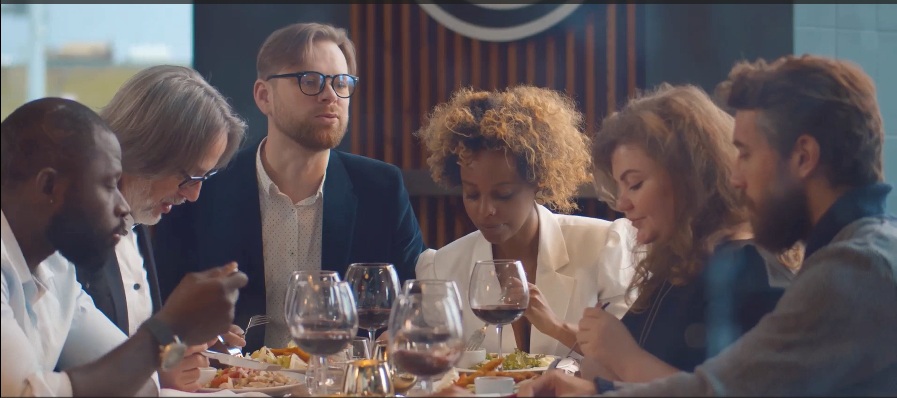A working knowledge of etiquette is critical for success in the professional world.
Nowhere are manners more evident than during a business meal.
WORD FORMATION:
Change the word in CAPITALS to fill in the blanks.
There’s more to dining etiquette than knowing which fork to use. A real pro will walk away from the table leaving others with a favorable impression, setting the stage for the next steps in the relationship. Whether you’re a host or guest, table manners will set you apart in a positive or negative way.
As a host, a meal allows you to build and 1. …………. [STRONG] connections with people important to your success. When you’re the guest, you’re giving potential business partners insight into your personality as well as your 2. ………… [PROFESSIONAL]. As a prospective job candidate, your host is watching to see how you conduct yourself and how you will represent their company as an 3. ………. [EMPLOY].
It’s crucial to have your dining etiquette skills polished and ready to shine for any business opportunity that comes your way.
Here are 8 steps for success at your next power meal.
Remember you’re working.
A business meal is an 4. ……….. [EXTEND] of your workday. It’s half networking opportunity and half business meeting – not a happy hour with friends. (…)
Set the agenda.
Some meals are more social in nature, such as a dinner to bond with a prospective client, while others are held to delve into the nitty-gritty details of a business deal. Let your 5. ………..s [INVITE] know what you have in mind when you extend an invitation so they’re prepared.
It’s not about the food.
Don’t go to a business meal starving. Eat something in advance so you can focus on the conversation, not on cleaning your plate. Always avoid ordering 6. ………. [MESS] or complicated items, such as spaghetti,(…) or crab legs.
Show your 7. ………… [SOPHISTICATE].
As a host, take responsibility for every detail after you extend an invitation: choosing the venue, selecting the table, setting the pace of the meal and paying the bill. (…)
Job interviewees, take note: if the 8. …………… [INTERVIEW] doesn’t reach for the check, that’s a red flag that they may not be an ideal employer because it may be an 9. …………….. [INDICATE] they struggle with paying their employees.
Know which drink is yours.
Be familiar enough with the table settings to know which is your bread plate and which is your glass (…).
Be aware of your body language.
Show you’re engaged by sitting up straight and remembering the other rules your mother taught you: chew with your mouth closed, don’t talk with your mouth full, avoid pointing with your utensils and keep your elbows off the table. (…)
Turn your cell phone off.
Turn off your ringer and keep your technology out of sight. Answering a call or responding to a text shows your dining companion they’re not your top priority. Give your tablemate(s) your full attention.
Be ready to talk.
In a world where we often eat hurriedly alone at our desks, a business meal takes away other 10. ……………s [DISTRACT] and requires us to make conversation. Bring your best networking moves to the table, ready with general topics of discussion: the restaurant, food, sports, movies, TV shows, interesting news and avoiding polarizing subjects such as politics. (…)
In order to read the whole article/check your answers, go to: https://www.inc.com/diane-gottsman/mastering-the-art-of-a-business-meal.html
Key: 1. strengthen; 2. professionalism; 3. employee; 4. extension; 5. invitees; 6. messy; 7. sophistication; 8. interviewer; 9. indication; 10. distractions
Glossary
- to delve into – to try hard to find out more information about something
- nitty-gritty – the basic facts and important details of a situation:
- to fall short of something – to fail to reach the standard that you expected or need
Practice makes perfect
Complete each gap in the video excerpt with 1 word.
It is such a sort of instrumental part 1. ……… our cooking vocabulary in terms of the utensils. I was like, huh, that’s interesting, there are people out there 2. ……. live without chopsticks. Chopsticks are a pair of two long sticks 3. …….. to eat things with one hand.
Holding chopsticks is a little bit like holding a pencil, except that you have two of them and you kind of move them together in a pincher movement. Most of them are 4. …….. out of wood, they’re also made out of plastic, bamboo, jade, gold, silver, and even ivory, though I think that’s not so cool these days anymore. Chopsticks are really well designed 5. ……. eating small 6. ……. of food.
They’re good for picking up noodles, if you 7. …… really skilled you can eat rice, you can pick up dumplings, little pieces of meat. 8. ……. are definitely some no-no’s with chopsticks. You should not use chopsticks like drumsticks, which I know is very, very tempting.
You definitely don’t want to stick chopsticks into a bowl of rice face up, and the 9. ……. for that is it actually looks like a bowl of incense, so it sort of echoes death. Chopsticks are used in a huge portion of 10. ….. world, across much of Asia, about 1.5 billion people are covered in the chopstick sphere. Different cultures have slightly different variations of chopsticks. (…)
Now watch the video and check your answers:
Key: 1. of; 2. who; 3. used; 4. made; 5. for. 6. bits; 7. ‘re/are; 8. There; 9. reason; 10. the
Discuss
- Have you ever attended a business meal or formal dinner? What was the occasion and how did it go?
- What are some specific ways a person can make a good impression during a business meal?
- What could happen if someone behaves too casually at a business meal?
- Have you ever experienced or witnessed an awkward situation related to paying the bill at a meal? How was it resolved?
- Are these dining etiquette tips the same in your culture, or are there differences? Give examples.
- What are some good conversation starters that are safe and professional?
- In your culture, are there specific conversation rules or taboos during meals?
- Do you find it easy or difficult to make small talk in professional settings? Why?
- How should someone prepare when attending a business meal with people from a different culture (e.g., where using chopsticks is expected)?
- Have you ever dined in a culture very different from your own? What surprised you about the table manners or dining traditions, and how did you adapt?
Watch and Revise!
Mastering Business Meal Etiquette
A Global Guide
https://www.cloud.worldwideschool.pl/index.php/s/QL3BS48iYKDr6xj
(6202)






